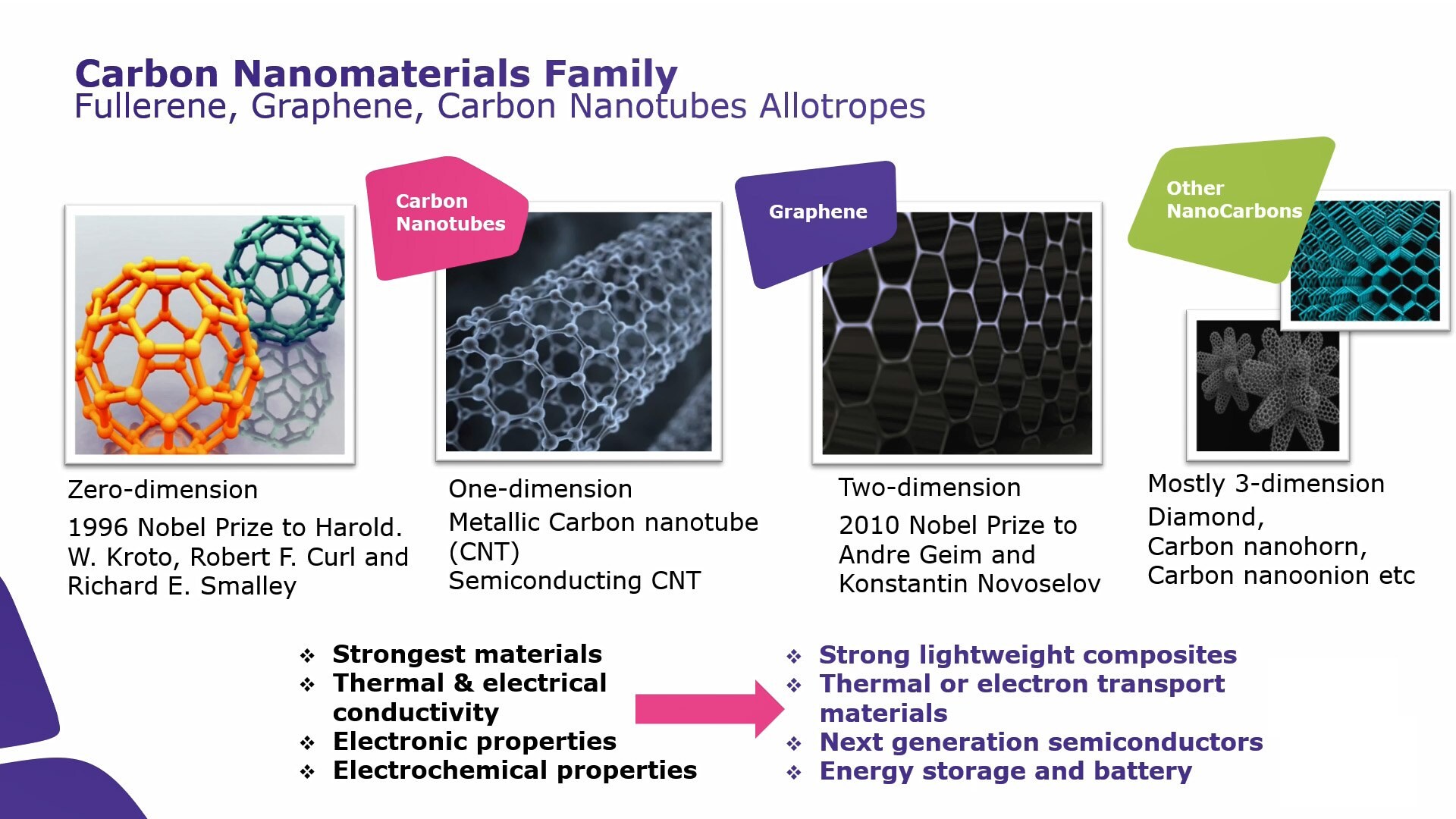Carbon Nanomaterials

Carbon nanomaterials are an extensive family of carbon allotropes, consisting of 0-dimensional fullerenes and quantum dots, 1-dimensional carbon nanotubes (CNTs), 2-dimensional graphene, and 3-dimensional nanodiamonds and nanohorns. Carbon nanomaterials are used in a broad range of applications due to their unique physical and chemical properties. Explore our comprehensive portfolio of innovative carbon nanomaterials to empower your scientific breakthroughs. For more information on nanostructured materials, please refer to our nanomaterial tutorial.
Products
Fullerenes
Fullerenes are also called Buckyballs. We offer a large variety of fullerenes from C60 to C70, C76, C78 and C84, either in their pristine form or with functional groups that assist in their dispersion and processing. Fullerenes find application in lightweight composites, catalyst supports, bioscience, and alternative energy applications. The scalability of our fullerene products allows you to easily bring your product ideas into reality.
Carbon Nanotubes
Carbon nanotubes can be classified according to their number of concentric walls as single-walled nanotubes (SWCNTs), double-walled nanotubes (DWCNTs), or multi-walled nanotubes (MWCNTs). The diameter and helical angle of single-walled carbon nanotubes (SWCNTs) have a dramatic effect on their electronic properties, causing some nanotubes to behave as metallic conductors and others as direct band gap semiconductors. Our chirality-specific SWCNTs are optimal for fabrication of high-performance electronics based on field-effect transistors. Our drawable multi-walled carbon nanotube (MWCNT) arrays facilitate easy processing of pure MWCNT into useful macroscopic forms, such as films and fibers, without the need of destructive post-treatments that typically damage the structure and property of pristine CNTs or compromise their performance in the end applications. Due to CNT’s high aspect ratio, electric conductivity, outstanding thermal conductivity and strong mechanical properties, they support cutting-edge applications in flexible transparent conducting screens, bioelectronics, artificial muscles, fiber electronics and smart textiles.
Graphene
Graphene is one of the most promising carbon nanomaterials. Graphene has an atomically thin single-layer structure, high surface area, and robust mechanical and electrochemical properties. It has been the focus of research for electronics, energy, lightweight composites, and biomedical applications. Researchers have demonstrated that two graphene layers placed on top of each other can conduct electrons with no resistance if they are twisted at an effective “magic angle”, or become an insulator completely, to switch device property enormously. Our collection of graphene, graphene nanoribbons, and graphene oxide-based materials are available in various forms, to enable easy incorporation into all of your applications.
Nanodiamonds
Our fluorescent nanodiamonds are highly stable bioimaging tools with low toxicity, high biological compatibility, and infinite photostability. The absence of photoblinking, long fluorescence lifetime (>10 ns), and ease of biofunctionalization help you achieve success in your research endeavors.
Carbon-Based Quantum Dots
Discover our nontoxic carbon quantum dots and graphene quantum dots with good solubility, stable photoluminescence, and better surface grafting, thus making them promising candidates for replacing inorganic quantum dots.
Other Carbon Nanomaterials
We also offer other carbon nanomaterials such as carbon nanohorns (CNHs) and carbon nanofibers (CNFs). Our remarkable CNHs offer high surface area, high electrical and thermal conductivities, as well as good solution processability, combined with large-scale production capability. CNHs are a viable option for catalyst support, gas storage, energy storage, drug delivery, and phototherapy.
Our CNFs are discontinuous, highly graphitic, highly compatible with most polymer processing techniques, and can be dispersed in an isotropic or anisotropic mode. They are cost-effective materials with excellent mechanical properties, high electrical conductivity, and high thermal conductivity, which can be imparted to a wide range of matrices including thermoplastics, thermosets, elastomers, ceramics, and metals. CNFs also have a unique surface state, which facilitates functionalization and other surface modification techniques to tailor/engineer the nanofiber to the application.
To continue reading please sign in or create an account.
Don't Have An Account?

